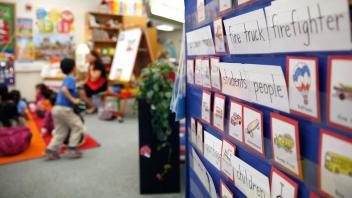When students learn conceptually challenging academic vocabulary words in school, do students notice them beyond school, or do they tune into the new words only during formal vocabulary lessons?
How can we supplement the limited time we have for direct vocabulary instruction while motivating students to be excited about and attentive to the ways in which new words are used in authentic contexts in the world around them? In the Media is an out-of-school vocabulary activity intended to do just that. Part of a larger program to provide robust direct instruction of words found in academic texts, In the Media is a simple way for teachers to expand students’ opportunities to encounter the words they are learning in a wider range of contexts than can be provided by direct instruction alone.
Recent reports and test results suggest that as students reach their intermediate and middle school years, too few are reading at levels needed to learn from required school texts (American Institutes for Research, 2006; Heller & Greenleaf, 2007; National Association of State Boards of Education, 2005; National Center for Education Statistics, 2011). The vocabulary demand of texts that students are assigned in school is cited as a major contributor to reading problems.
Specifically, the recently released vocabulary data from the National Assessment of Education Progress (National Center for Education Statistics, 2012) affirm the crucial link between the words students know and students’ ability to use those words to understand what they read. These data suggest that we must do more to help students build a deep, flexible understanding of the kinds of words that are used in academic texts.
Context for "In the Media"
In the Media is one part of a larger instructional intervention called Robust Academic Vocabulary Encounters (RAVE) designed to enhance students’ knowledge of academic words and comprehension of academic texts (McKeown et al, 2012). RAVE provides direct instruction of academic words selected from the Academic Word List (AWL; Coxhead, 2000). The AWL was developed from a 3.5-million-word corpus that covers 28 content domains and consists of words that commonly appear across academic texts. For example, 10 of the words most frequently found across domains are analysis, benefit, concept, derived, established, factors, indicate, legal, method, and occur.
The instruction in the RAVE intervention is based on a consensus of principles of effective vocabulary instruction that has emerged over several decades (Baumann et al, 2003; Kieffer & Lesaux, 2012; McKeown et al, 1985; National Reading Panel, 2000; Stahl & Fairbanks, 1986). These principles are presentation of definitional and contextual information, encounters with words in multiple contexts, and active processing of word meanings.
Recent theoretical work based on results from neuroscience seems to align with these principles. Reichle and Perfetti’s (2003) word experience model and Perfetti’s Lexical Quality Hypothesis (Perfetti, 2007; Perfetti & Hart, 2002) suggest that as experiences with words accumulate, a learner builds abstracted representations of word meanings. Representations that are based on a rich network of connections built from experiencing words in multiple, informative contexts will likely be complex, flexible, and nuanced, allowing the learner to bring the most relevant connections to bear to help understand newly encountered contexts.
RAVE engages students in multiple encounters with each word during seven-day cycles of direct instruction for sets of AWL words. Students are taught 99 words across 11 cycles of instruction. Every RAVE word within a cycle is introduced using two authentic contexts adapted from diverse print and Internet-based resources across a wide range of domains including science, sports, the arts, history, mythology, government, health and wellness, and media.
Along with a friendly definition that captures a core meaning for each word, students use the authentic contexts to discover and discuss the ways in which each word can be used. For example, the instruction for accommodate first exposes students to the physical sense of the word in a context about the number of people that will fit on the world’s largest Ferris wheel.
The companion context about ways in which many countries are altering their paper money to accommodate the needs of blind citizens illustrates a second sense of the word. The friendly definition makes each of these senses accessible in easy to understand language: If you accommodate someone or something, you are able to make room for them or give them something they need.
Every activity in a RAVE instructional cycle is designed to engage students in active processing of the word and the ways it can be used. For example, in learning the word accommodate, students do the following:
RAVE has been piloted in sixth grade in a public middle school in a working class community. The population is approximately 75% white and 25% African American, with 50% of the students receiving free or reduced-price lunch. To assess the effects of the RAVE intervention, we administered several assessments, including the Gates-MacGinitie reading comprehension test (MacGinitie et al, 2000) and a researcher-designed test of word knowledge.
The word knowledge measure comprised four cloze sentences for each taught word and required students to determine whether the target word made sense in each of the sentences. The measure tested students’ knowledge of multiple senses of words (e.g., physical and mental sense of confine). Results showed significant growth in word knowledge compared with control students on the word knowledge test, but no pre- to posttest differences on the Gates-MacGinitie reading comprehension measure (McKeown et al., 2013).
- Answer questions such as “How might your family accommodate a pet monkey?” “How is your school schedule changed to accommodate a special assembly?”
- Recognize “Some buses can handle riders who have their bikes with them,” “The car in the haunted house could only hold two people,” and “Making our house safe for our visiting baby cousin” as examples of accommodating someone or something.
- Debate whether an attendance policy should be consistent (another RAVE word in the cycle) for all students or accommodate the circumstances of individual students.
- Write a conclusion to this sentence: “When our grandpa moved in, we tried to accommodate him by ———-.”
Design of "In the Media"
The purpose of including In the Media as an activity in the RAVE intervention was to motivate students’ interest in vocabulary and to encourage their learning of the target words. We believed that finding the words outside of class would help students realize that these words are indeed important to language, not just as a part of classroom exercises. Additionally, we hypothesized that encountering the words outside of class would reinforce their learning by allowing students an even greater variety of contexts and uses for the words than we could provide, even within an intensive intervention such as RAVE.
The In the Media activity was introduced to students at the end of the first cycle of RAVE instruction and was available for students to participate in throughout the rest of the intervention. In the Media was an adaptation of Word Wizard, an activity to encourage interest and awareness of vocabulary in studies with fourth graders (Beck et al, 1982; McKeown et al., 1985).
For the Word Wizard activity, students were encouraged to find the words being taught outside of class, and they could earn classroom rewards if they reported seeing, hearing, or using the words. With In the Media, we attempted to take an updated, more sophisticated approach designed to appeal to the sixth graders with whom we were working and to tap into the modern media in their daily lives. In the Media challenges students to find RAVE words beyond their vocabulary lessons and outside of school in books, websites, newspapers, billboards, bus ads, radio, television, video games, magazines, menus, music, and so forth.
When students see or hear one of the words, they fill out a “word deposit slip” indicating the word, where they encountered it, and how it was used. (An example of a student’s word deposit slip is shown in Figure 1.) They deposit these in a designated area in the classroom and earn a point for each deposit. Points are recorded on a chart in the classroom. (See Figure 2 for an example of a chart for recording In the Media points.) When a student accumulates 10 points, he or she receives a reward, such as a homework pass, bonus points, extra computer time, or another incentive determined by the teacher.
Figure 1. Example of a Student “In the Media” Deposit Slip
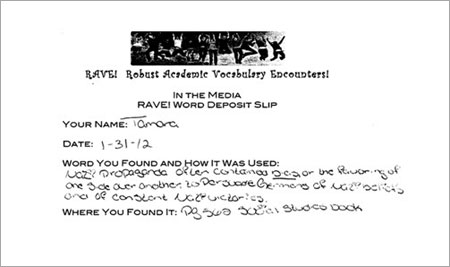
Figure 2. Example of an In the Media Chart Posted in the Classroom
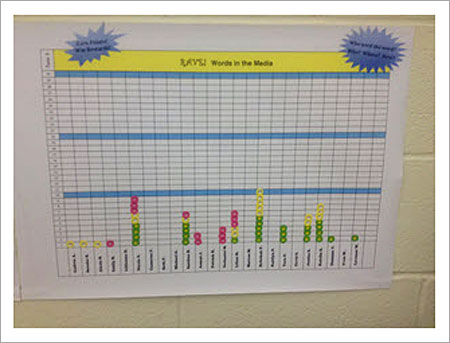
To introduce and generate excitement for In the Media, we “advertised” the challenge with a colorful brochure that was given to all students participating in RAVE (Figure 3). We also provided a laminated bookmark for each nine-word cycle of instruction for students to keep in their backpacks, post on their refrigerators, or use in any way they chose to remind them of the words they should be looking for.
Figure 3. Example of In the Media Brochure Given to Students to Launch the Challenge
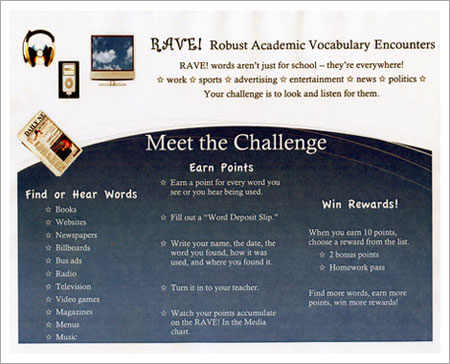
Note: The total number of In the Media encounters reported by students during the school year was 709.
Student participation in "In the Media"
Although In the Media is a voluntary activity, many students responded right away to our challenge to find words outside of school and immediately began bringing in deposit slips. Data from the implementation of RAVE during the 2011–2012 school year demonstrate that the level of engagement was high, and most students took part. Across the 6 months of instruction, 51 of the 61 students receiving RAVE instruction participated. The level of participation varied widely, from one student submitting just 1 deposit slip to another student submitting an impressive 120. The average was 12 submissions per student.
We wondered whether participation in In the Media was influenced by student ability. Were the most engaged, high-achieving students more likely to participate? To answer this question, we examined the relationship between students’ scores on the Gates–MacGinitie reading test and their In the Media participation. We found virtually no relationship between the two (Pearson product-moment r = 0.18). We also found virtually no relationship between students’ overall reading ability as measured by the Gates and the total number of RAVE academic words that they encountered in their environment (r = 0.09). Participating students represented the full ability range.
We did find, however, that participation varied by classroom, and this variation could not be explained by the level of encouragement and motivation provided by the teacher. There were two participating teachers in the project, one who taught the intervention in one of her language arts classes (class A) and another who taught it in two of her classes (classes B and C). Interestingly, the biggest difference was between the two classes taught by the same teacher. The number of encounters reported in class A ranged from 0 to 62. The number of encounters in classes B and C, respectively, were 0–121 and 0–17.
This led us to believe that although students’ encounters with the words occurred mostly outside of school as an individual experience, participation in In the Media was also very much a social phenomenon. Excitement about encountering RAVE words and the accumulating point totals seemed to build among the students in class B and motivated more students to get involved in looking and listening for words.
To prompt fuller participation, we provided an occasional boost in motivation in the form of a “Double Points Challenge.” In a designated 24-hour period, students could earn 2 points for every word they encountered and submitted a deposit slip — akin to double miles offers in frequent flyer programs. These challenges were very successful! Of course, many of the eager students took advantage of this opportunity, but, more important, students who had not participated previously began taking part. We suspect that there are many other ways to stoke interest and participation in In the Media, but we have seen from our own experience that students’ attentiveness to target words in their environment does respond to prompting.
Where students found the RAVE words
The answer is, everywhere! Books were the most common source, which we found very gratifying. Approximately 43% of the encounters came from books, as shown in Figure 4. Students found the words in their science books frequently. Commonly cited contexts included “potential energy,” “natural features,” and “a variety of processes.” The students were reading Anne Frank: Diary of a Young Girl (Frank, 1952) in social studies and found the book rich with instructed words, such as “sustained by her warmth and her wit,” and a reference to “traditions of the old empire.” Not surprisingly, out-of-school reading encounters in the Twilight series and The Hunger Games were common.
Figure 4. Sources of RAVE Words Encountered by Students Outside of School
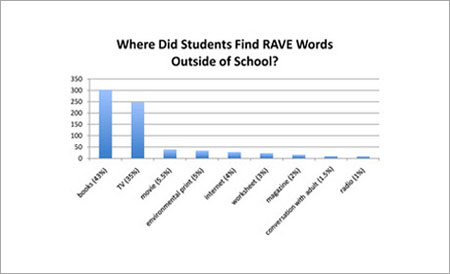
As might be expected, the next most common source was television, accounting for 35% of the submitted word deposit slips. Quite a few encounters came from news and weather broadcasts, such as a forecast of “isolated thunderstorms.” The Discovery Channel and Animal Planet were popular, and the TNT hit Bones was cited. Legal shows seemed popular, including NCIS and Harry’s Law, and the Food Network got a few mentions, such as “It is hard to sustain the flavor.” Other sources included the Internet, movies, catalogs, and environmental print.
The most heartening signs that students were really tuning in to words in their world were the unlikely sources of encounters they reported. This kind of evidence suggests that students were developing an awareness of words even in brief, passing, nonacademic contexts. Some of our favorites of this type were:
- Encountering consume on a silica packet marked “do not consume” inside a newly purchased purse
- Encountering drama as the word dramatization in the corner of a television commercial for Clinique products
- Hearing sports broadcasts that featured dominant players
- Encountering words during church activities, including, “Everyone has a unique friendship with God,” and, “Cast your cares upon the Lord and he will sustain you.”
- Noting that on Facebook you can have mutual friends
- Finding a poster in the school’s main office announcing the criteria for Student of the Month
- Noticing the warning on a crystal growing kit about the “potential of burning if you have contact with skin.”
Our candidate for the most unusual source was a context from Mail Pro Magazine citing the decline in first class mail. We could only speculate that someone in the family worked for the United States Postal Service.
Effect of the word source on student understanding
Although students were encouraged to both look and listen for the words they were learning, we noticed a difference in the richness of the reported encounters depending on the source. In particular, reports of encounters from books usually appeared complete and were readily comprehensible.
Reports of encounters with a word in something students had heard, however, were more varied. They were often brief, incomplete, and were sometimes a bit off the mark. For example, three students reported an encounter with the word suspend at a football game. The first student reported: “The lights at the field were suspended.” Our first thought was that the lights were physically suspended in the air. The second student wrote: “The power suspended at the field.” Oh, we thought, so the power was cut off. Then, we read the third student’s response, which brought clarity: “They had to suspend the football game because the power went out.” All three students heard the announcement suspending the game, but for the first two students, the role of suspend in the situation did not seem as securely represented in their memory of the event.
Other reports that suggested less secure memories of the contexts encountered came from instances of hearing the words while watching television. Following is the entirety of what the student reported on the word deposit slip for each context:
- “Is to cling to the notion”
- “Help them unify each other”
- “Sustain — there was a judge saying it in court”
Of course, encounters with words in aural contexts are more difficult to report, because they are fleeting, whereas text contexts remain available for students to record the exact context in which the word was found and to grapple with what it means in that context. Yet the permanence of text, combined with the fact that textual encounters can provide fuller, richer contexts and display more deliberate use of specific words than casual aural encounters, prompts a question of whether students might build higher quality representations from encountering the words in text. That text encounters provide a stronger foundation for experiencing vocabulary is not surprising, but the variation we found in students’ responses offered a glimpse into that phenomenon.
What students gained from "In the Media"
Influence on Word Learning
Although we were encouraged by the level of student participation and the range of sources students reported for their RAVE word encounters, we wanted to know whether participation in In the Media influenced how well students learned the RAVE words. We explored that question by examining our results from the pre/post word knowledge test described earlier that we administered as part of the RAVE sixth-grade intervention.
When we examined the results in relation to students’ participation in In the Media, we found a significant, positive relationship between taking part in In the Media and students’ gain scores from pretest to posttest (r = 0.30, p < .05). In particular, gains seemed to relate not to the absolute number of encounters reported by students, but instead to the number of different RAVE words students reported encountering outside of school.
Interestingly, the relationship seemed to be strongest for students with a substantial number of encounters with different RAVE words (10 or more). Students who reported encountering fewer RAVE words included both students with low gain scores as well as those with average and high gain scores. However, students who reported encountering many different RAVE words had consistently high gain scores.
This finding reflects the effect of the Word Wizard activity mentioned earlier. In a study that compared type and frequency of vocabulary instruction for fourth graders, students who, in addition to receiving vocabulary instruction, had the option of participating in the Word Wizard activity experienced an extra boost to their comprehension of text containing instructed words (McKeown et al., 1985).
Flexibility with Word Forms and Senses
Across both text and aural encounters, students readily developed flexibility with different forms and senses of the words and gained exposure to idiomatic expressions in which the words often appear. One example of this was students’ encounters with the word expose. The definition shared with students in RAVE instruction was: “If you expose something, you let it show or make it known.” Contexts about the words included physically exposing things that had been beyond reach, such as miners blasting off a mountain to expose coal; being shown or introduced to new experiences, such as students being exposed to different styles of music; and revealing qualities or conditions, such as exposing someone for mistreating a dog.
With their In the Media contributions, students provided evidence of all of these uses of the word, in addition to a further and somewhat distinct sense — that of being vulnerable to outside forces. Examples of this included “You feel foolish, exposed, stupid. You want to follow that candy wrapper into the trash can” from the book Stargirl (Spinelli, 2000), and “He felt exposed along the bare edge of the gorge” from the book Warriors: Firestar’s Quest (Hunter, 2007).
Another word that showcased students’ tapping a variety of sources and uses for their encounters was benefit. The definition presented to students was: “When you benefit from something, it means you get something good from it, and it is helpful to you.” The contexts used to introduce the word were the ways nursing home residents benefit from pet visits and the ways playing sports can benefit teenagers.
In the Media encounters with the word benefit helped students stretch their awareness about the meanings and uses of the word beyond their classroom interactions with it. For example, students found several instances of the word in “health and employee benefits.” This represents another sense of the word and a different part of speech that still fits with the core meaning the students had learned. Students also found idiomatic uses of the word benefit, such as “giving someone the benefit of the doubt” and doing something “for someone’s benefit.”
The flexibility that students exhibited extended to helping students understand words as members of word families. Students found examples of the word beneficial related to their RAVE word benefit, as well as insignificant and insignificance (in the family of the RAVE word significant) and exceedingly (in the family of the RAVE word exceed). This flexibility with related forms of a word is sure to be an asset to word learning, as suggested by Anglin’s (1993) work on morphological problem solving.
Anglin showed that an important part of vocabulary growth in the middle childhood to adolescent years occurs through children’s ability to figure out the meanings of morphologically complex words by integrating knowledge of base words and affixes. In the Media offered students opportunities to practice this aspect of knowledge building.
Although direct vocabulary instruction can introduce students to a core definition and engage them with different senses of a word, it can be difficult to provide sufficient instructional opportunities to present the full range of a word’s uses. Prompting students to be attuned to the use of words in their environments casts a broader net for idiomatic use and prototypical sentence constructions.
Broader Set of Connections
The In the Media program may have had another, broader benefit for students’ word learning, but one that is more difficult to measure. According to theoretical accounts of word learning, knowledge of a word accumulates with each encounter (Landauer et al, 2011; Reichle & Perfetti, 2003). Each new experience with a word offers students the opportunity to make new connections to words and experiences already in their repertoire. Thus, even encounters that seemed sparsely represented, such as sustain being reported as “used by a judge in a courtroom,” offered an additional facet of word knowledge — here, that sustain is appropriate to courtroom contexts. An enriched set of connections to a word can in turn enable a learner to leverage word meaning to make sense of new contexts in which the word is met.
Conclusions
At the outset of this endeavor, we had to wonder whether students would actually notice and engage with these words outside of school. Our findings demonstrate that indeed they did. First, a preponderance of the students in our pilot group of 61 sixth-grade students voluntarily participated in In the Media, and the students who participated most enthusiastically were not just the high-achieving students, but represented the full ability range of students with respect to prior reading achievement.
In the Media both spurred student interest in words and heightened their awareness of words in their world. Even though the words students were learning are academic words, they easily were able to find them on television, on the radio, in novels, at the movies, and in a wide variety of other media. It became a motivating challenge to see just where they might discover the next word.
Additionally, our data suggest that asking students to look for their vocabulary words outside of school appears to be a way to enrich students’ word learning, yet the activity is highly efficient because it takes virtually no classroom time. Students with the highest levels of participation showed the greatest gains in their understanding of the instructed words. Although we cannot say for certain that participating in In the Media was a determining factor in enriching students’ word learning, our experience suggests that the opportunities to encounter words in ways that supplemented direct vocabulary instruction helped students more quickly develop nuanced and accurate representations of word meanings.
Our experience with In the Media has given us more information about what works for middle school students to achieve a level of excitement and awareness about words, where students are encountering words in their daily lives, which students are engaged in looking and listening for words, ways to motivate all students, and the impact of serendipitous encounters on student vocabulary learning.
Note
We gratefully acknowledge the Institute for Education Sciences of the U.S. Department of Education for its support of the work described in this article. The opinions expressed do not necessarily reflect those of the Institute, and no official endorsement should be inferred. The authors express thanks to the teachers, students, and administrative team at Logan Middle School for their gracious efforts and cooperation.
Biographies
Margaret G. McKeown is a senior scientist at the Learning Research and Development Center, University of Pittsburgh, Pennsylvania, USA; e-mail mckeown@pitt.edu.
Amy C. Crosson is a research associate at the Learning Research and Development Center, University of Pittsburgh, Pennsylvania, USA; e-mail acrosson@pitt.edu.
Nancy J. Artz is a research specialist at the Learning Research and Development Center, University of Pittsburgh, Pennsylvania, USA; e-mail nartz@pitt.edu.
Cheryl Sandora is a research associate at the Learning Research and Development Center, University of Pittsburgh, Pennsylvania, USA; e-mail sandora@pitt.edu.
Isabel L. Beck is professor emerita at the University of Pittsburgh, Pennsylvania, USA; e-mail ibeck@pitt.edu.
McKeown, Margaret G., Crosson, Amy C., Artz, Nancy J., Sandora, Cheryl, Isabel L. Beck (2013). In The Media: Expanding Students’ Experience with Academic Vocabulary. The Reading Teacher, 67(1), 1–9.
